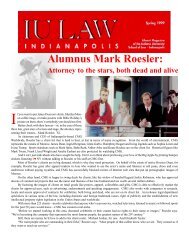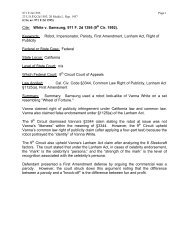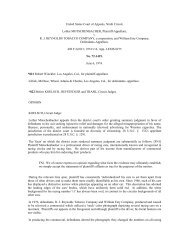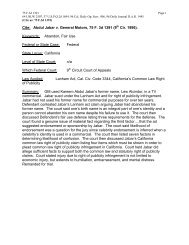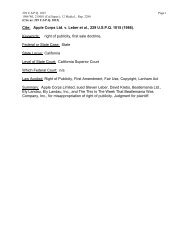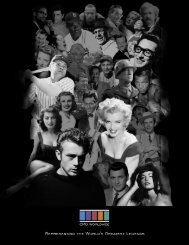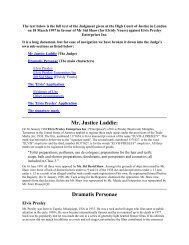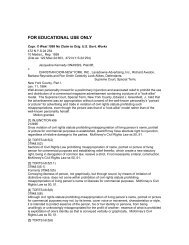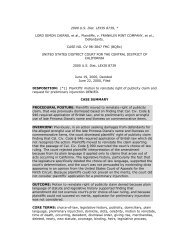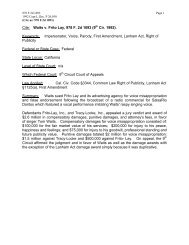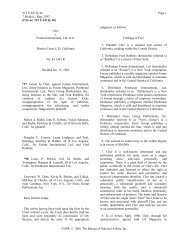Namath v. Sports Illustrated - Mark Roesler
Namath v. Sports Illustrated - Mark Roesler
Namath v. Sports Illustrated - Mark Roesler
- No tags were found...
Create successful ePaper yourself
Turn your PDF publications into a flip-book with our unique Google optimized e-Paper software.
FOR EDUCATIONAL USE ONLYCopr. © West 1999 No Claim to Orig. U.S. Govt. Works371 N.Y.S.2d 101 Media L. Rep. 1843(Cite as: 48 A.D.2d 487, 371 N.Y.S.2d 10)Joseph W. NAMATH, a/k/a Joe <strong>Namath</strong>,Plaintiff-Appellant,v.SPORTS ILLUSTRATED, a Division ofTime Incorporated, and TimeIncorporated,Defendants-Respondents.Supreme Court, Appellate Division,First Department.July 10, 1975.properly and fairly depicted, andlanguage of advertisement did notindicate athlete's endorsement ofthe magazine, there was no invasionof athlete's right to privacy inviolation of Civil Rights Law.Civil Rights Law §§ 50, 51.*488 **11 Martin E. Silfen, NewYork City, of counsel (StephenGillers, New York City, with him onthe brief, Carl R. Sloan, New YorkCity), for plaintiff-appellant.Professional athlete brought actionagainst magazine publisher forviolation of his right of privacyunder Civil Rights Law. The SupremeCourt, Special Term, Harold Baer,J., 80 Misc.2d 531, 363 N.Y.S.2d276, granted defense motion todismiss, and plaintiff appealed.The Supreme Court, AppellateDivision, Capozzoli, J., held thatwhere use of professional athlete'sphotograph was merely incidental toadvertising of publisher's magazinein which athlete had earlier beenproperly and fairly depicted, andlanguage of advertisement did notindicate athlete's endorsement ofthe magazine, there was no invasionof athlete's right to privacy inviolation of Civil Rights Law.Affirmed.Kupferman, J.P., filed a dissentingopinion in which Murphy, J.,concurred.TORTS k8379k8Where use of professional athlete'sphotograph was merely incidental toadvertising of publisher's magazinein which athlete had earlier beenHarold R. Medina, Jr., New YorkCity, of counsel (Kenneth M. Kramer,New York City, with him on thebrief, Cravath, Swaine & Moore, NewYork City), for defendant-respondentTime Incorporated.Before KUPFERMAN, J.P., and MURPHY,CAPOZZOLI, LANE and NUNEZ, JJ.CAPOZZOLI, Justice:Plaintiff sought substantialcompensatory and punitive damages byreason of defendants' publicationand use of plaintiff's photographwithout his consent. Thatphotograph, which was originallyused by defendants, withoutobjection from plaintiff, inconjunction with a news articlepublished by them on the 1969 SuperBowl Game, was used inadvertisementspromotingsubscriptions to their magazine,<strong>Sports</strong> <strong>Illustrated</strong>.The use of plaintiff's photographwas merely incidental advertising ofdefendants' magazine in whichplaintiff had earlier been properlyand fairly depicted and, hence, itwas not violative of the Civil
Rights Law (Booth v. CurtisPublishing Co., 15 A.D.2d 343, 223N.Y.S.2d 737, aff'd, 11 N.Y.2d 907,228 N.Y.S.2d 468, 182 N.E.2d 812).Certainly, defendants' subsequentrepublication of plaintiff's picturewas 'in motivation, sheeradvertising and solicitation. Thisalone is not determinative of thequestion so long as the law accordsan **12 exempt status to incidentaladvertising of the news mediumitself'. (Booth v. CurtisPublishing Co., supra, p. 349, 223N.Y.S.2d p. 744). Again, it wasstated, at 15 A.D.2d p. 350, 223N.Y.S.2d p. 744 of the cited case,as follows:'Consequently, it suffices herethat so long as the reproduction was used toillustrate the quality and content of theperiodical in which it originally appeared, thestatute was not violated, albeit thereproduction appeared in other media forpurposes of advertising the periodical.'Contrary to the dissent, we deemthe cited case to be dispositivehereof. The language from the<strong>Namath</strong> advertisements relied upon inthe dissent, does not indicateplaintiff's endorsement of themagazine <strong>Sports</strong> <strong>Illustrated</strong>. Hadthat been the situation, acompletely different issue wouldhave been presented. Rather, thatlanguage merely indicates, to thereaders of those advertisements, thegeneral nature of the contents ofwhat is likely to be included infuture issues of the magazine.The order of the Supreme Court, NewYork County, entered *489 onFebruary 5th, 1975, grantingdefendants' motion for summaryjudgment dismissing the complaintherein, and the judgment enteredthereon on February 10th, 1975,should be affirmed, with costs.*490 Order, Supreme Court, New YorkCounty, entered on February 5, 1975,and judgment entered thereon onFebruary 10, 1975, affirmed.Respondents shall recover ofappellant $60 costs anddisbursements of this appeal.All concur except KUPFERMAN, J.P.,and MURPHY, J., who dissent in adissenting opinion by KUPFERMAN,J.P.*489 KUPFERMAN, Justice(dissenting).It is undisputed that one Joseph W.<strong>Namath</strong> is an outstanding sportsfigure, redoubtable on the footballfield. Among other things, as thestar quarterback of the New YorkJets, he led his team to victory onJanuary 12, 1969 in the Super Bowlin Miami.This feat and the story of the gameand its star were heralded withillustrative photographs in theJanuary 20, 1969 issue of <strong>Sports</strong><strong>Illustrated</strong>, conceded to be anoutstanding magazine published byTime Incorporated and devoted, asits name implies, to the activitiesfor which it is famous. Of course,this was not the first nor the lasttime that <strong>Sports</strong> <strong>Illustrated</strong>featured Mr. <strong>Namath</strong> and properly so.The legal problem involves the useof one of his action photos from theJanuary 20, 1969 issue in subsequentadvertisements in other magazines aspromotional material for the sale ofsubscriptions to <strong>Sports</strong> <strong>Illustrated</strong>.**13 Plaintiff contends that theuse was commercial in violation ofhis right of privacy under ss 50 and51 of the Civil Rights Law. See, ingeneral, 'The Muddled State of Lawof Privacy' by J. Irwin Shapiro,N.Y.L.J., May 16 and May 19, 1975,p. 1, col. 3. Further, that becausehe was in the business of endorsingproducts and selling the use of hisname and likeness, it interfered
with his right to such sale,sometimes known as the right ofpublicity. Haelan Laboratories v.Topps Chewing Gum, 202 F.2d 866 (2ndCir. 1953). Defendants contend thereis an attempt to invade theirconstitutional rights under theFirst and Fourteenth Amendments bythe maintenance of this action andthat, in any event, theadvertisements were meant to show'the nature, quality and content' ofthe magazine and not to trade on theplaintiff's name and likeness.Initially, we are met with thedetermination in a similar case,Booth v. Curtis Publishing Co., 15A.D.2d 343, 223 N.Y.S.2d 737 (1stDept.) Aff'd without op., 11 N.Y.2d907, 228 N.Y.S.2d 468, 182 N.E.2d812 (1962) relied on by Baer, J., inhis opinion at Special Termdismissing the complaint.The plaintiff was Shirley Booth,the well-known actress, photographedat a resort in the West Indies, upto her neck in the water and wearingan interesting chapeau, which photo*490 appeared in Holiday Magazinealong with photographs of otherprominent guests. This photo wasthen used as a substantial part ofan advertisement for Holiday.Mr. Justice Breitel (now ChiefJudge Breitel) wrote:'Consequently, it suffices herethat so long as the reproduction was used toillustrate the quality and content of theperiodical in which it originally appeared, thestatute was not violated, albeit thereproduction appeared in other media forpurposes of advertising the periodical.' 15A.D.2d at p. 350, 223 N.Y.S.2d at p. 744.attracted attention. In the <strong>Namath</strong>advertisement, we find, in additionto the outstanding photograph, inCosmopolitan Magazine (for women)the heading 'The Man You Love lovesJoe <strong>Namath</strong>', and in Life, theheading 'How to get Close to Joe<strong>Namath</strong>.' There seems to be tradingon the name of the personalityinvolved in the defendants'advertisements.This distinction between actualadvertising use and use to inform,Cf. Bigelow v. Virginia, 421 U.S.809, 95 S.Ct. 2222, 44 L.Ed.2d 600(1975) means that cases like Time,Inc. v. Hill, 385 U.S. 374, 87 S.Ct.534, 17 L.Ed.2d 456 (1967) andCantrell v. Forest City PublishingCo., 419 U.S. 245, 95 S.Ct. 465(1974) involving so-called 'falselight' portrayal are of onlyincidental interest. It is also adistinction **14 accepted by Mr.Justice Breitel in that herecognized a right 'to have one'spersonality, even if newsworthy,free from commercial exploitation atthe hands of another . . .' Booth v.Curtis Publishing Co., supra, 15A.D.2d at p. 351, 223 N.Y.S.2d at p.745.The complaint should not have beendismissed as a matter of law.MURPHY, J., concurs.END OF DOCUMENTHowever, the situation is one ofdegree. A comparison of the Boothand <strong>Namath</strong> photographs andadvertising copy shows that in theBooth case, her name is inexceedingly small print, and it isthe type of photograph itself which
*END*END*END*END*END*END*END*END*END*END*END*END*END*END*END*END*END*END*END*1341694 - WRIGHT,AMYDate and Time Printing Started: 01/20/99 04:31:28 pm(Central)Date and Time Printing Ended: 01/20/99 04:31:29 pm(Central)Offline Transmission Time: 00:00:01Number of Requests in Group: 1Number of Lines Charged: 154*END*END*END*END*END*END*END*END*END*END*END*END*END*END*END*END*END*END*END*



